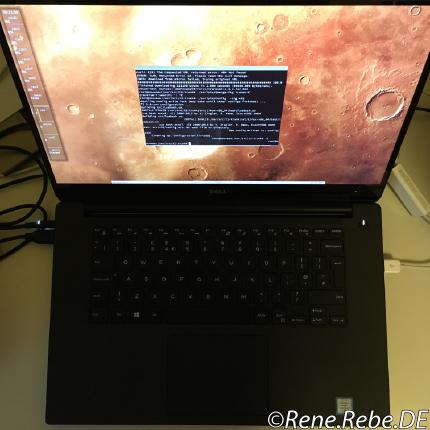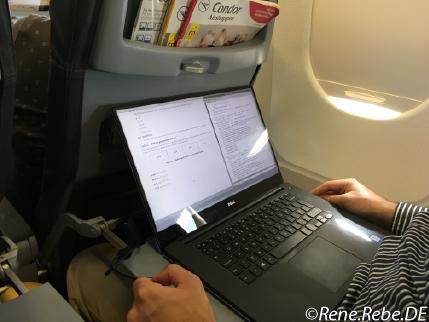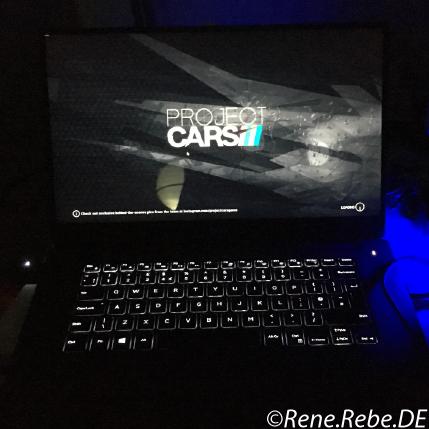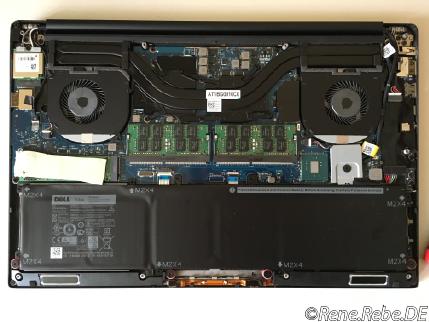Dell XPS 15 and Linux - a developer’s dream
This is one of the few and longer review articles I write on this site, for two reasons. First of all I am pretty dissatisfied with Apple’s laptops (and workstations) for a decade, and second Dell provided me with XPS 15 to try for a few weeks.

For some background, I actually came to Apple’s hardware thru Linux PowerPC development. Back in that days iBooks and PowerBooks just worked 100% with Linux, with all features, bits and whistles. From suspend-to-ram (when most PC’s ACPI would just crash and burn) to WiFi and unparalleled battery life (in my memory I remember it somewhere between 3 to 5 hours).
I usually had iBooks, as I never liked the AluBooks. Neither the design (with at that time ugly gray-ish plastic border), over the scratchy surface, that is cold in winter, hot in summer, and gives you some electric fizz on bad international power grids (like, US, UK, Taiwan, or Russia), sigh.
In the early Intel transition days I started with a black polycarbonate MacBook that was mostly ok, but had some power rail regulator whine, and breaking top case plastic border, …
In latest years Apple leaves us no choice and buy into this Aluminium madness, sigh.
The latest MacBooks are also less and less satisfactory for me: The are usally pretty outdated, lagging an Intel Core-i generation or two behind and have plenty of compromises: The MacBook Air for example always came with extremely crappy (sorry) TN displays, the new MacBook comes with next to no ports (definetly nothing for me), and in general they have nothing user serviceable anymore: not the RAM, nor the battery, and officially also not the even flash storage. Sigh. As a developer I now always end up overspending on maxing out the RAM and SSD on purchase, and still constantly fight with free space on the SSD (I’m a software developer, much of my work comes with huge image data, test sets, VMs, …).
Needless to say what a non-upgradable and outdated disappointment the new MacPro is (I still got an old Mac Pro tower, though, …).
Given my overall high dissatisfaction with Apple’s offerings (totally unrelated of Dell sending me this XPS15 for review, as you can see in my decade old quest for a perfect notebook documented on this site) I take a look on alternatives for the next one.
So the best thing is that I’m not 100% trapped in Apple’s reality distortion field. We still continued to develop Windows and Linux solutions. So instead of running Linux and Windows VMs in VMWare on a MacBook I simply switch over to run the VMs and Linux development in QEMU/KVM VMs. The benefit of not letting a vendor lock you in.
From all the PC offerings the current XPS 15 (and 13) fill most of my needs nicely. The have a gorgeous composite carbon fiber / CNC machined aluminum case that in my designer eyes is subjectively more beautiful than Apple’s all-aluminum. As added benefit the carbon fiber body is isolating you from the power grid, so you are protected form this warm electric fuzz the AppleMacBook sometimes give you. Personally I also like the darker design more (I also have the black polycarbonate MacBook).
The Dell 4k IGZO IPS screen is obviously one huge over 8 million pixels piece of gorgeous. I personally do not really need the touch capabilities though, and would rather prefer a mate screen. While there is a mate 1080p options, all the 4k screen real estate is just perfect for plenty and sharp source code text. The natural HiDPI scaling of the display is 250%. In my opinion a 200% scaling display would be enough and certainly allow for slightly higher frame-rates and longer battery time. I guess the 4k displays are simply easier to source, than custom panels with slightly less pixels (and 4k certainly works better for advertising). However, nothing is perfect and you can not have each cake and eat it too, … On the upside those who prefer slightly smaller text could simply run it with a 200% scaling, …
On the peripheral side the ports of the XPS 15 are pretty modern, with two USB 3 ports, an USB C with Thunderbolt port, HDMI, a headphone jack (yay!) and a SD card reader. The only downside is that for an external high resolution 4k@60Hz display one needs to use the USB C port. And reliable USB C 4k adapter cables are still rare. What is a really nice feature for road-warriors and bringing back memory of user replaceable MacBook batteries is the LED bar battery indicator at the side.
All this and the 15″ 4k display are cramped into a rather compact 14″ footprint with only a slim bezel around the screen (I wonder for years why Apple needs to have such a big one, particularly on the MacBook Air, …).
The 14″ body makes the laptop not only fit better in many slim travel and messenger bags, it is also exactly that centimeter that is always in the way on economy Y-class airplane seats.

A call to (Web?) developers
While I understand: The macOS UI is (mostly) pretty and such. But why are you still enduring this vendor lock-in and far fromm ideal and outdated hardware when you can run the Linux flavor of your choice on any other good laptop hardware?
On the Windows side
I personally do not see so many shiny thing. Windows 10 is still a mess with the crazy outdated Win32 garage-invented API mess. Even some Window’s internal windows are still so legacy that they do not even HiDPI scale properly (device manager, low-level network config and what not). On the Dell XPS 15 default install is also strange, that some Dell PremierColor App is consuming some 15-17% CPU while idling. What the power wasting heck?
On the performance side
As I mostly use Linux and macOS performance comparison is not all so easy. Needless to say the XPS 15 is usually more than blazing fast. But I want to give you one real world number of (the only) game I at times play: Project Cars - and I have an external Windows 8 USB storage for that. So using exactly the same Windows 8 installation on the same physical drive I have a shocker for you: comparing the last generation Retina MacBook Pro, 16GB RAM, NVidia GTX 750 to the Dell XPS. With some medium details on an (older 1050p) Apple Cinema Display the rMacBookPro manages some at the border-to-be-playable 25fps. But I do not really want to decrease track details, … So the Dell XPS 15 (mind you the exactly same installation) runs with 60fps refresh rate limited !!! I thought the internal 4k display would be unplayable, but to my surprise using the Dell’s XPS 15 internal 4k display with the same detail setting runs at a bit over 25fps!
To summarize: while the rMacBookPro can push out 1050p with 25 fps the XPS can either do 1050p at 60fps or 4k at a bit over 25 fps. Not bad at all! So much for waiting a year or two for Apple to bump their spec to the latest Intel silicon generation.

In terms of raw CPU power the XPS 15 compares equally impressive to even the newest Retina MacBook Pro, as Apple is still shipping a two (!!!) generations older Core i7 as you can read in the performance sneak peak I posted some weeks ago - where a timed Linux compile completes about 35% (7 minutes!) faster. Seven from 20 minutes is certainly noticeable when you wait for your task –compile, big-data, render, …– to complete.
On the Linux side
As I did not wanted to mess with Dell’s Windows installation for when I return the unit, I booted my standard T2 SDE external portable USB C SSD installation that I also use for other development and testing, e.g. on either the rMacBookPro, or the Surface Pro 3 and such.
With my classic, keep it stupid and simple T2 installation mostly everything just worked out of the box. Intel and NVidia graphics, trackpad, WiFi, backlight dimming, heck even the touch panel just auto-configured and worked™. Without any “tuning” with Linux I get around 5 hours of battery life when using my existing external USB C SSD install.
A note about other reviews
In many reviews I read about opening the display requires some force and holding the body. Honestly, opening my rMacBookPro is not so much “easier” and I prefer a steady screen over easy opening, … Some reviewers are also not so warm with the keyboard. Coming from MacBooks I’m already used to chicklet keys for a decade and I would say the Dell XPS 15 is not too different from the MacBook Pros; certainly much better than the new, non-Pro MacBooks, …
The only thing I personally need some getting used to is the Ctrl key left of the Fn key. While I know many die-hard PC users find this normal and preferable. However, coming from over a decade on Macs I find stretching my small finger less more natural. This kind of things -a Ctrl and Fn key being visa versa even on some PCs- are exactly the things that driver users crazy. And honestly, using mostly Apple gear I face the same confusion in the office, each time I grab a older, classic Apple keyboard without Fn key in the lower left corner. Sigh.
tl;dr
The Dell XPS 15 is a state of the art laptop with gorgeous black is beautiful design language and best in class HiDPI, 4k IGZO IPS screen. Despite it slim case, and screen bezel it even has “user” serviceable parts, such as socketed RAM, and SSD. Yay! If times comes, maybe regular users can even get the battery out themselves ;-)
Contrary to what Apple wants it’s users and the congress (right to repair) to believe: Dell even publishes a service manual straight on their own website!

If Dell maintains this no compromise design language over the coming years I think they could even win over and pick up the legacy of the former Thinkpad fame.
To purchase this for myself I’m only worried about three points: On some online stores (such as Amazon) one can find negative customer reviews about irregular build quality. I hope this are only rare outlines - as investing into such a pricy mobile workstation random manufacturing glitches are obviously not acceptable. Second I am not sure about the long term durability of the rubbery composite carbon fiber top case finish. My fear is that after typing for a year or two the rubbery area around the keyboard could wear off and result into an rather unpleasant peeling effect (only time will show). And last but not least, if there every should be a problem dealing with Dell’s famous customer support, … (not that dealing with Apple support would be that much better, though). Sigh.
It was a pleasure to work on the XPS 15 with Linux the last weeks and it is definitely my number one machine on my personal shopping wish-list. It will be a welcome change not to have to invest into overpriced (RAM, SSD) and outdated (Intel Core-i what?) MacBooks anymore. In terms of options, Dell provides nice entry level models with mate 1080p screen, various Intel, RAM and and raven cheaper spinning hard disk configuration. If you like it smaller you can chose form the XPS 13 models, including a no-Windows-tax Developer Edition.
The good:
- awesome HiDPI 4k display
- small and compact
- outer case battery indicator (like former MacBooks)
- socketed RAM, SSD, …
- service manual
The bad:
- glossy display
- ctrl / fn key position
Could not care less
- touch display
- webcam below the screen

September 16th, 2016 at 17:44
Hi Rene,
thanks for the review. Personally, I like the MBPro aluminum body - except for the electrostimulation when you connect to an ungrounded power system. But that is just a matter of taste.
I agree with you, that the MBPro is disappointing with regards to the hardware. Until 15 years ago, apple was all about getting the best silicon you could fit into a stylish case and bundling with a rock solid, and easy to use OS.
Today, the iPhone is apple’s cash cow, and the macbooks degraded into a mere accessory gadgets for occasional users, who use it to surf the web and sort their icloud photo galleries. Don’t get me wrong, I have no problem with these kind of users, but besides mainstream products, apple should offer a macbook series that deserve the Pro suffix. The XPS series shows how much apple is lacking there.